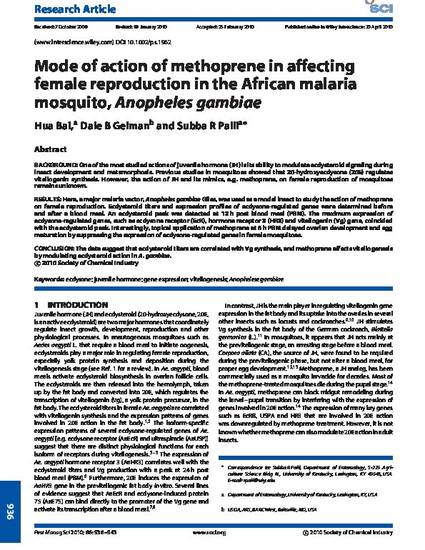
Article
Mode of action of methoprene in affecting female reproduction in the African malaria mosquito, Anopheles gambiae
Pest Management Science
(2010)
Abstract
BACKGROUND: One of the most studied actions of juvenile hormone (JH) is its ability to modulate
ecdysteroid signaling during insect development and metamorphosis. Previous studies in mosquitoes showed that 20-hydroxyecdysone (20E) regulates vitellogenin synthesis. However, the action of JH and its mimics, e.g. methoprene,on female reproduction of mosquitoes remains unknown.
RESULTS: Here, a major malaria vector, Anopheles gambiae Giles, was used as a model insect to study
the action of methoprene on female reproduction. Ecdysteroid titers and expression profiles of
ecdysone-regulated genes were determined before and after a blood meal. An ecdysteroid peak was
detected at 12 h post blood meal (PBM). The maximum expression of ecdysone-regulated genes, such as
ecdysone receptor (EcR), hormone receptor 3 (HR3) and vitellogenin (Vg) gene, coincided with the
ecdysteroid peak. Interestingly, topical application of methoprene at 6 h PBM delayed ovarian
development and egg maturation by suppressing the expression of ecdysone-regulated genes in female
mosquitoes.
CONCLUSION: The data suggest that ecdysteroid titers are correlated with Vg synthesis, and
methoprene affects vitellogenesis by modulating ecdysteroid action in A. gambiae.
Keywords
- ecdysone,
- juvenile hormone,
- gene expression,
- vitellogenesis,
- Anophelese gambiae
Disciplines
Publication Date
September, 2010
DOI
10.1002/ps.1962
Publisher Statement
Works produced by employees of the U.S. Government as part of their official duties are not copyrighted within the U.S. The content of this document is not copyrighted.
Citation Information
Hua Bai, Dale B Gelman and Subba R Palli. "Mode of action of methoprene in affecting female reproduction in the African malaria mosquito, Anopheles gambiae" Pest Management Science Vol. 66 Iss. 9 (2010) p. 936 - 943 Available at: http://works.bepress.com/hua-bai/9/
